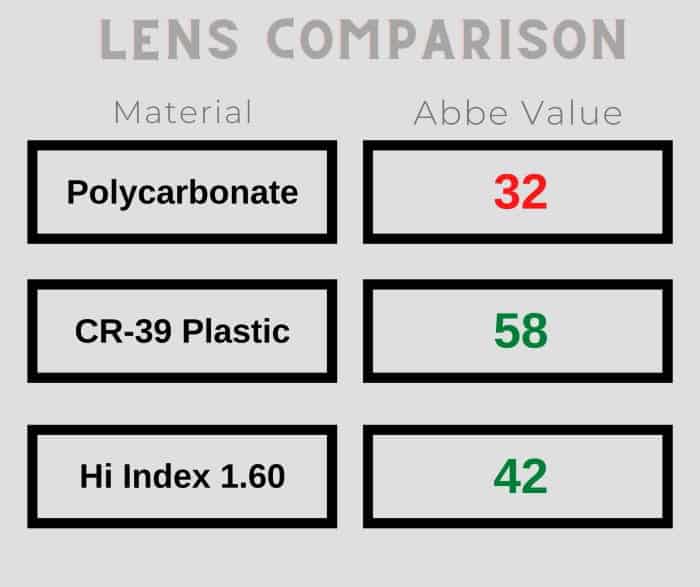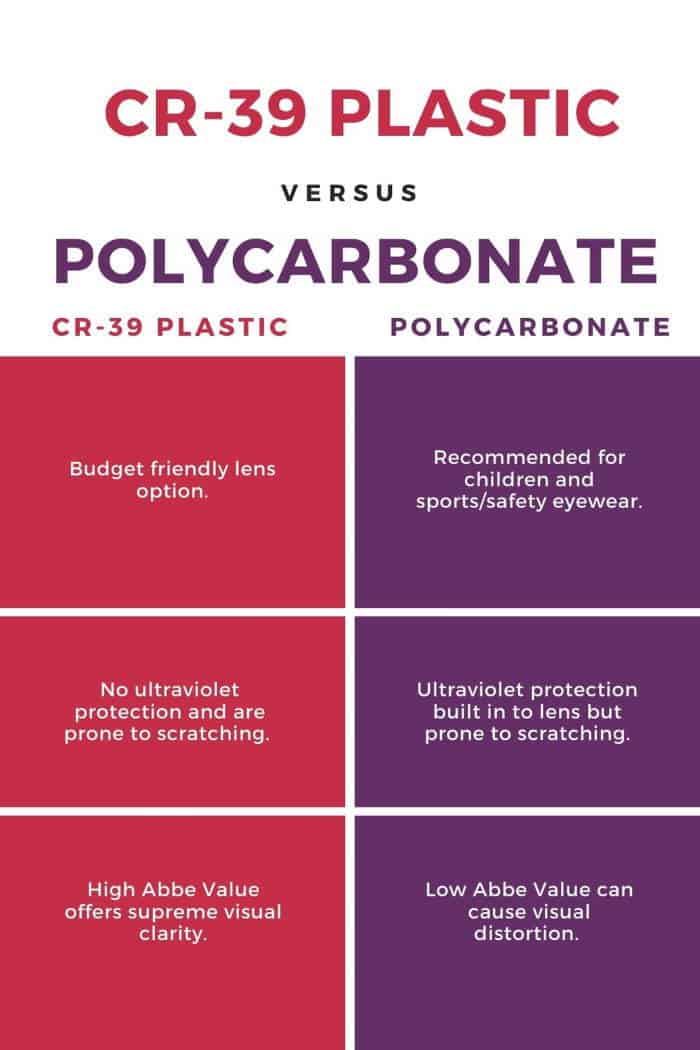If you’ve spent any time shopping for new glasses online, you’ve likely encountered the choice between polycarbonate or plastic lenses during checkout. Which should you go with?
There are many benefits and drawbacks to each lens type, so it’s important to know the facts before making your final choice! Below, we’ll explore both lens materials and how they compare in durability, cost, and visual clarity.
(This page contains affiliate links. OGR may receive compensation if you click a link and make a purchase.)
Plastic: The Starter Lens

Plastic eyewear lenses, also known as CR-39 lenses, have been around since around 1947.
Before then, opticians used glass lenses to fabricate prescription lenses. Plastic lenses were a great innovation because they offered high optical quality, lower cost, lighter weight, and more impact resistance compared to glass.
As a result, plastic lenses are now the material of choice in budget-friendly lens packages. However, it’s important to note that it scratches easily and doesn’t offer any ultraviolet protection.
Plastic lenses are also thicker than other lens options. On the plus side, they are easy to tint and a good option for sunglasses lenses.
Polycarbonate: The Upgrade Lens

Polycarbonate lenses are another type of plastic material. Introduced in the 1980s, they’re incredibly lightweight and about 20% thinner than regular plastic lenses.
Additionally, they have a superior level of impact resistance and are suggested for both children’s glasses and safety eyewear.
This lens is also a great choice if you select a rimless frame and your lenses need to be drilled or grooved.
Polycarbonate lenses are slightly more expensive than standard plastic lenses. However, since they have UV protection built-in, there is no need to pay for added protection.
You can also tint polycarbonate lenses, but they don’t accept color as well as plastic lenses. If you need sunglasses and a polycarbonate lens, polarized or photochromic options will work well.
One thing to keep in mind is polycarbonate lenses are very easy to scratch. To make your lenses last longer, adding a scratch-resistant coating is recommended.
Visual Clarity
Besides lens thickness, there is a difference in visual clarity between plastic and polycarbonate lens materials.
Every lens material has what is called an abbe value. The abbe value measures how much the lens material disperses light.
A lens with a low abbe value causes a higher dispersion and leads to unwanted visual distortion. This visual distortion is referred to as chromatic aberration.

When you are experiencing chromatic aberration, the image you see through your lenses looks blurred, or you will notice colored edges around objects.
Plastic lenses have the highest abbe value of any plastic lens. Therefore, they have a minimal amount of visual distortion and high optical clarity.
On the other hand, polycarbonate lenses have a very low abbe value. This prohibits certain individuals from wearing this lens type comfortably due to extreme visual distortion and discomfort.

The distortion is usually more noticeable in higher prescriptions.
Hi-Index lenses are even thinner than polycarbonate lenses and have a higher abbe value. This is your best option if you cannot adapt to polycarbonate due to distortion issues and require a thinner lens.
Hi-Index vs. Polycarbonate Lenses
Which Is Better For My Prescription: Plastic or Polycarbonate?
If you are on a budget, regular plastic lenses are the most affordable choice. However, if you have a higher prescription (above +/- 3.00), polycarbonate lenses are thinner and lighter and will result in a much nicer-looking pair of eyeglasses.
Many online retailers include single-vision CR-39 plastic lenses in the cost of the frame. Some even include polycarbonate single-vision lenses in the price, such as Warby Parker or Liingo Eyewear.
When Should I Order Polycarbonate Lenses?
Polycarbonate lenses are always recommended for children due to their impact-resistant properties. This lens type is also suggested if you will be using your glasses for sporting activities.
Law enforcement officers and military personnel can also benefit from the impact resistance of polycarbonate.

If you are shopping for new eyeglasses, be sure to ask about all the lens materials available. You can then apply the information you have learned here to determine which lens type best suits your needs.